
Illustration of tree, cone, and foliage [Matt Strieby, 2021].
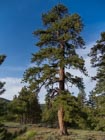
An open-grown tree in the eastern Cascade Mountains [C.J. Earle, 2015.05.16].
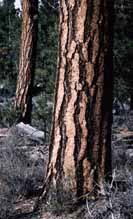
Mature tree growing in a selectively logged area, Big Hole, Oregon [C.J. Earle, 1998.04.17].

Bark, about 30 cm across [C.J. Earle].
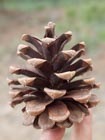
Cone from a tree in the eastern Cascade Mountains [C.J. Earle, 2014.05.25].
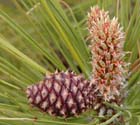
Actively elongating shoot and start-of-second-summer cone [C.J. Earle, 2002.05.25].

Ripe pollen cones. This tree is also infected with a dwarf mistletoe (Arceuthobium sp.), visible at the bottom of the photo [C.J. Earle, 2015.05.25].

For over half a century, the largest known tree in subspecies ponderosa has been this giant, living on the shores of the Deschutes River in La Pine State Park, Oregon [C.J. Earle, 2018.08.19].
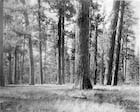
Stand of old-growth P. ponderosa near Whitney, Oregon, ca. 1900 [J.W. Cowden] (courtesy Gary Dielman, Baker City library).

Pinus ponderosa subsp. ponderosa
Douglas ex Lawson 1836
Common names
Ponderosa pine, Columbia Basin ponderosa pine, North Plateau ponderosa pine.
Taxonomic notes
Syn: P. ponderosa var. ponderosa. Populations from northern California and Oregon/Washington west of the Cascade crest that some authors have assigned to subsp. ponderosa are here treated under subsp. benthamiana. Populations from extreme northeastern California and western Nevada that some authors have assigned to P. washoensis are here treated under subsp. washoensis.
P. ponderosa subsp. ponderosa includes populations from British Columbia, western Montana, Idaho, and Washington, Oregon, California, and Nevada east of the Cascades/Sierra Nevada crest. Haplotype data (see "Taxonomic notes" for P. ponderosa) indicate that a single haplotype predominates in the Montana, northern Idaho, northern Washington, and Cascade Range portion of the subspecies' range, while another haplotype predominates in central Idaho and eastern Oregon (Potter et al. 2013). Each of these haplotypes is, separately, closely related to a third haplotype that predominates on the wet western side of the Cascades, Sierra Nevada, and points west. It may be that the north/easterly haplotypes represent separate processes of radiation from a Pleistocene refugium located in a southern locale; Potter et al. (2013) cite paleoecological evidence of P. ponderosa occurrence in the southern Sierra Nevada during the last glacial maximum as the closest known presence of the species at that time. It is also possible that a refugium existed in the Klamath-Siskiyou region; although no fossil evidence has been found of P. ponderosa, many other plants are known to have weathered the last glacial maximum by persisting in this area.
Description
Evergreen monoecious trees to 50 (-69) m tall and 150 (-277) cm] DBH. Stem usually straight and robust; branches thick and persistent; usually one whorl per year; usually 3 to 6 in a whorl; branches inserted at an average angle of 51° from apex of the stem of young trees. Bark on mature trees vertically fissured, dark brown or dark gray to black; on old trees becoming pale yellow to orange, thick, with broad plates separated by shallow fissures. Xylem resin odor (discernible in bark crevices warmed by the sun) usually like vanilla, turpentine, or lemon rind. Needles finely serrate, sharp-tipped, finely lined with stomata on all faces, 14-25 cm × 1.5-2 mm, dark green to blue-green, paler and shorter at higher elevations and under xeric conditions; generally not glaucous, but becoming glaucous at higher elevations and with the onset of winter; flexible and in fascicles of three; remaining green on stem an average of 2.2-7.6 years, remaining green longer at higher elevations; persisting on branch only a few years, giving a tufted appearance to branches; enclosed at the base by sheaths of papery bracts that are, in the first year, 10-15% of needle length but that weather away to leave a thick, dark brown to black sheath 4-8 mm long on the oldest fascicles. Vegetative buds covered with loosely appressed ovate acute scales that are conspicuously fringed with short brown hairlike projections; scales light chestnut-brown or gray brown, dotted with resin during summer, sometimes covered with resin during winter. Vegetative shoots green or brownish green and sticky, elongating once each year. Pollen cones borne in clusters of 5-30, dark red to reddish purple, long-cylindrical, 20-70 mm long. Seed cones in first year 15 to 25 mm long, on stalks half as long; red on emergence, turning greenish brown, with short, appressed, mucronate scales; prickles usually erect; when mature, symmetrical and straight to slightly curved, average 89 mm long, long-ovoid to globose; color during second summer typically reddish brown to dark purple but occasionally green; subsessile; deciduous during the first winter after ripening, with a very short stalk and a few basal scales usually persisting temporarily on branch after the cone falls. Seed cone scales 134 to 137, slightly concave, usually rounded at apex; apophysis yellow to brown, lustrous, slightly elevated along a transverse keel; umbo salient and forming base of a stout, persistent prickle usually directed outward, but occasionally slightly reflexed; adaxial surface slightly concave and dull tawny to red brown; abaxial surface dark brown, purplish, or blackish. Seeds dark brown or speckled; acute-ovoid; width about two-thirds of length, averaging 4-5 x 6-8 mm. Seed wings 3.3 to 4.3 times length of seed, average length 17 mm, thin, semitransparent, pale brown, sometimes darkly streaked with brown, widest at or slightly below midpoint, apex rounded. 2n=24 (Callaham 2013, Kral 1993, and my observations). See P. ponderosa for a table detailing differences from the other taxa commonly called "ponderosa pine".
Distribution and Ecology
Canada: British Columbia; USA: Washington, Oregon, NW Nevada and NE California east of the Cascade crest (at Fort Lewis, Washington, it grows west of the Cascade Mountains due to edaphic drought conditions created by an extremely porous glacial outwash substrate). Habitat montane, dry, open forests at 0-2,300 m elevation (Kral 1993).
Distribution data for the various taxa that have been called "Pinus ponderosa", i.e. P. arizonica, P. brachyptera, P. ponderosa, and P. scopulorum, including subspecies and varieties. Data downloaded on 2021.12.15 from the Consortium of California Herbaria, the Consortium of Midwest Herbaria, and the Consortium of Pacific Northwest Herbaria, limited to geolocated records with coordinate uncertainty less than 10 km. Note that there are probably some misidentifications; for instance, P. scopulorum is unlikely to be found in the North Cascades. Most records include a link to the original herbarium record.
The IUCN does not recognize this taxon as distinct from subsp. benthamiana or subsp. washoensis. However, it is still probably accurate to assess subsp. ponderosa as "least concern" under IUCN criteria due to its extensive area of occupancy and the limited scope of its threats.
Remarkable Specimens
Clearly the largest tree is the LaPine Pine, which can be seen at LaPine State Recreation Area in LaPine, Oregon. It has a stem volume of 114 m3, dbh 277 cm, height 50.6 meters. This giant is well-known and has been celebrated for many years. The tallest tree known, and the largest ponderosa in Idaho, is 69.5 m tall and 184 cm dbh. It grows in Boise County (Robert Van Pelt e-mail 2004.02.04). Formerly, the largest in Washington was the Trout Lake Pine in Gifford Pinchot National Forest near Trout Lake, Washington; it died in the early 21st century. It had a stem volume of 92 m3, dbh 213 cm, height 64.9 meters (Van Pelt 2000); currently, the Washington champion tree is undefined.
A ring-counted age from a good core is reported by Robert Van Pelt (pers. comm. 2007.10.18) for a tree growing on Meek's Table east of Chinook Pass, Washington. That core had 876 rings. Based on core height and distance from pith, the tree was estimated to be 907 years old.
Ethnobotany
This is a valuable timber tree, the harvest of which far exceeds regrowth because of high timber value and multiple uses of the wood (Kral 1993).
Observations
Since the species is so common within its range, only a few choice locales can be mentioned here. In Oregon, U.S. Highway 395 passes through many fine stands within Malheur National Forest. Excellent old-growth stands also persist in Pringle Falls Research Natural Area and Metolius Research Natural Area.
In Washington, fine old-growth stands may be seen along the Gotchen Creek Trail #40 and Cold Springs Trail #72 in Gifford Pinchot National Forest, and at campgrounds along the Chewack River, Okanogan National Forest. Not long ago, these areas were experiencing degradation due to long-term fire suppression, but both national forests have been implementing fuels control and prescribed fire programs, which may have helped restore these forests.
Some phenomenal stands can be found in the vicinity of Meeks Table, east of Chinook Pass, WA, shown below. These stands were neglected for many years, but starting in about 2005, forest managers have begun cutting out the invasive Abies grandis regeneration, thinning the stands, and instituting a prescribed fire regime. As a result, these forests have begun to resemble the extensive, open stands of large trees that were recorded by early travelers in the area.
Remarks
Don Lieuallen, near Pendleton, Oregon, reports (email 2005.11.12) that "Small trees that I cut down years ago with a lopper (oversized pruner tool) have regrown from their stumps. I cut as close to the ground as possible but some manage to regrow. This does not happen with trees which have attained some maturity before they are cut down for thinning." This is the only report I have found of stump sprouting in Pinus ponderosa.
This species is one of the primary hosts for the dwarf mistletoe Arceuthobium campylopodum (Hawksworth and Wiens 1996).
Citations
Callaham, R. Z. 2013. Pinus ponderosa: a taxonomic review with five subspecies in the United States. Research Paper PSW-RP-264, USDA Forest Service, Pacific Southwest Research Station, Albany, CA.
See also
Lanner (1983).
Lauria (1991).
Willyard, Ann, David S. Gernandt, Blake Cooper, Connor Douglas, Kristen Finch, Hassan Karemera, Erik Lindberg, Stephen K. Langer, Julia Lefler, Paula Marquardt, Dakota L. Pouncey, and Frank Telewski. 2021. Phylogenomics in the hard pines (Pinus subsection Ponderosae; Pinaceae) confirms paraphyly in Pinus ponderosa, and places Pinus jeffreyi with the California big cone pines. Systematic Botany 46:538–561.
Gallery
|

|
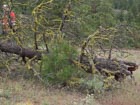
|
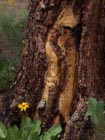
|
|
Culturally modified tree at Indian Trees Campground in the Bitterroot valley of Montana. Particularly in winter, aboriginal peoples would strip the inner bark of ponderosa pine to obtain forage for their horses [C.J. Earle, 2013.07.28].
|
Sapling growing beneath a "nurse" log in the eastern Cascade Mountains. In semiarid settings, winter snow accumulation and summer shade near logs provide a relatively benign temperature and water availability environment that facilitates seedling establishment [C.J. Earle, 2014.05.25].
|
At least two fire scars are visible at the base of this tree in the Wenas Creek watershed of eastern Washington. The small circular openings were created by wood-boring beetles [C.J. Earle, 2014.05.25].
|
|
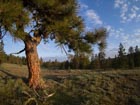
|
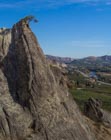
|

|
|
Ponderosa has a remarkable ability to survive in harsh environments. This one grows in a cold open meadow at high elevation in the eastern Cascades [C.J. Earle, 2015.05.17].
|
A tenacious tree clinging to the top of a sandstone pinnacle at Peshastin State Park, Washington [C.J. Earle, 2015.10.11].
|
Another gnarly little tree, living high in the eastern Cascades at the Red Top Lookout [C.J. Earle, 2015.10.11].
|















